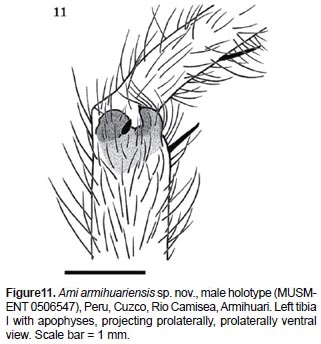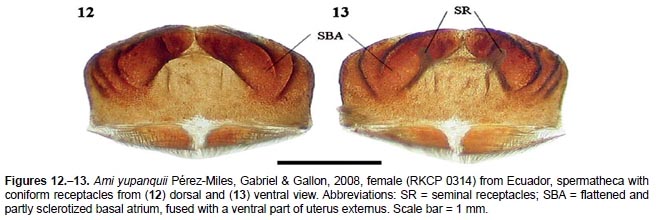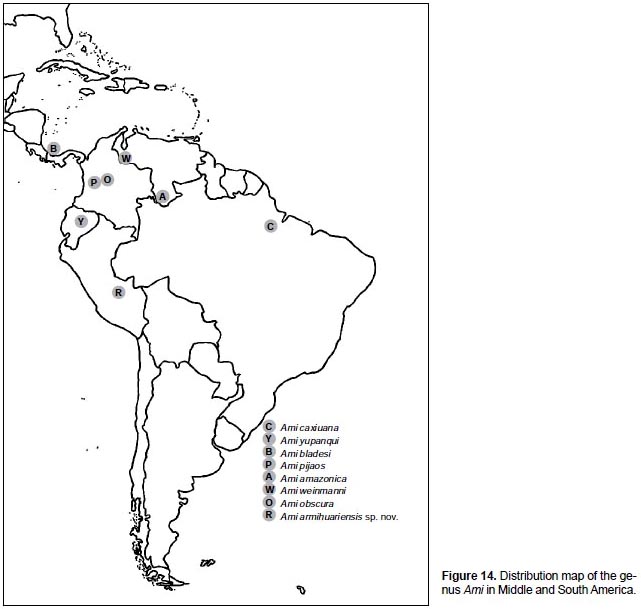Servicios Personalizados
Revista
Articulo
Indicadores
-
 Citado por SciELO
Citado por SciELO
Links relacionados
-
 Similares en
SciELO
Similares en
SciELO  uBio
uBio
Compartir
Revista Peruana de Biología
versión On-line ISSN 1727-9933
Rev. peru biol. vol.21 no.3 Lima dic. 2014
http://dx.doi.org/10.15381/rpb.v21i3.10906
TRABAJOS ORIGINALES
Ami armihuariensis, a new species from Peru (Araneae: Theraphosidae: Theraphosinae)
Ami armihuariensis, una especie nueva de Perú (Araneae: Theraphosidae: Theraphosinae)
Radan Kaderka
Abstract
Ami armihuariensis sp. nov. from Cuzco region, Peru is described, diagnosed and figured. Males of Ami armihuariensis sp. nov. differ from all other congeners, except A. pijaos, by the presence of only one retrolateral process on male palpal tibia, from A. pijaos by the granulation in tegular area of male palpal bulb. Additionally, photographs of A. yupanquii spermatheca are for the first time presented in order to emphasize the characteristic shape of spermathecae in this genus.
Keywords: Araneae; Mygalomorphae; South America; Peru; taxonomy.
Resumen
Se describe, diagnostica e ilustra Ami armihuariensis sp. nov. de la región de Cuzco, Perú. Los machos de Ami armihuariensis sp. nov. se diferencian del resto de sus congéneres, excepto A. pijaos, por tener una sola apófisis retrolateral en la tibia pedipalpal y de A. pijaos por la granulación en el área tegular de los bulbos pedipalpales de los machos. Adicionalmente, se presentan por primera vez fotografía de la espermateca de A. yupanquii para resaltar la forma característica de las espermatecas en este género.
Palabras clave: Araneae; Mygalomorphae; America del Sur; Perú; taxonomía.
Introduction
In 2008, Pérez-Miles et al. established the genus Ami to accommodate several small theraphosids from northern Brazil, Ecuador, Colombia, Venezuela and Panama, characterized by having modified type I urticating setae and other unusual characters which did not fit any known theraphosid genus, especially the shape of spermathecae in females and the presence of one or two subconical processes on male palpal tibia, in combination with a palpal bulb with very short and stout embolus carrying two prolateral keels.
In October 2013, during a study of spider collection in the Museum of Natural History in Lima, Peru, a single male of new species of Ami was discovered, differing from all other known species by the presence of one retrolateral process on palpal tibia and the micro-spikes in the tegular area of male palpal bulb. This new species is here described, diagnosed and figured.
At present the genus Ami which is exclusive to tropical regions of South and Central America comprises seven species: A. caxiuana Pérez-Miles, Miglio & Bonaldo 2008, A. yupanquii Pérez-Miles, Gabriel & Gallon 2008, A. bladesi Pérez-Miles, Gabriel & Gallon 2008, A. pijaos Jimenez & Bertani 2008, A. amazonica Jimenez & Bertani 2008, A. weinmanni Pérez-Miles 2008 and A. obscura (Ausserer 1875).
Material and methods
Abbreviations: Eye sizes and interdistances: AME = anterior median eyes, ALE = anterior lateral eyes, PME = posterior me-dian eyes, PLE = posterior lateral eyes, OQ = ocular quadrangle (including lateral eyes). Spination: p = prolateral, r = retrolateral, d = dorsal, v = ventral. Male palpal bulb: PS = prolateral superior keel, PI = prolateral inferior keel, A = apical keel. Cheliceral teeth pattern: v = small teeth, V = big teeth, - = space. PLS = posterior lateral spinnerets, PMS = posterior median spinnerets. MUSM = Museo de Historia Natural, Lima, Peru. RKCP = Radan Kaderka collection, Prague, Czech Republic.
Measurements were taken with an ocular micrometer accord-ing to the central axis of structures and are given in millimetres. The measurements of the leg and palpal segments were taken dorsally. The eye measurements were taken from the widest spans of the lens, AME in dorsal view, ALE, PLE and PME in dorsolateral view. The measurement of the total body length including cephalothorax and abdomen without spinnerets was made using a calliper.
The extent of tarsal and metatarsal scopulae on ventral side of both leg segments was expressed as a percentage of the total length of segment, from apical end.
The leg spination was described using a following method. Each leg segment was divided into four quadrants (ventral, prolateral, retrolateral and dorsal) and each quadrant described separately from basal to apical end. Unequal numbers of spines of the same leg segments on the right and left side were expressed by parentheses.
The terminology of male palpal bulb structures follows Bertani (2000).
The abdominal urticating setae were removed from the area of urticating setae by pincette, placed in alcohol and examined by a binocular microscope Leica S6D. The terminology of ur-ticating setae follows Cooke et al. (1972) and Bertani (2001). The barbs of urticating setae whose tips are oriented to the body are considered as reversed.
Taxonomy
-
Order: Araneae Clerck 1757
-
Infraorder: Mygalomorphae Pocock 1892
-
Family: Theraphosidae Thorell 1870
-
Subfamily: Theraphosinae Thorell 1870
Genus: Ami Pérez-Miles et al. 2008
Type species: Ami caxiuana Pérez-Miles, Miglio & Bonaldo 2008
Modified diagnosis: Ami males differ from all known thera-phosid genera by the presence of one or two subconical processes on the retrolateral surface of the male palpal tibia. Males and females have modified abdominal urticating setae of the type I, with area "b" (according Bertani 2001) longer than previously described (Cooke et al. 1972), similar to those found in Pro-shapalopus Mello-Leitão 1923 (Bertani 2001) and Citharacanthus livingstoni Schmidt & Weinmann 1996. Females of Ami differ from all other theraphosines by their characteristic spermathecae (Figures 12, 13) with paired ventral receptacles attached to an almost discrete, semicircular, sclerotized back-plate. Males also differ from all theraphosids by the palpal organ morphology, having prolateral keels that are more or less convergent (Pérez-Miles et al. 2008).
Ami armihuariensis sp. nov.
Type: Male holotype (MUSM-ENT 0506547) from Peru, Cuzco, Rio Camisea, Armihuari, 11°5151.3"S, 72°4645.6"W, altitude 579 m, May-June 1997, Saida Cordova col.
Etymology: The specific name refers to the type locality.
Diagnosis: Males of Ami armihuariensis sp. nov. differ from all other congeners, except A. pijaos , by the presence of only one retrolateral process on male palpal tibia, from A. pijaos by the granulation in tegular area of male palpal bulb.
Remarks: Although characters of the opposite sex, com-plementary to both holotypes of Ami armihuariensis sp. nov. and A. amazonica, are unknown for now, it is supposed that both are valid species in part due to the geographical difference between both type localities which are separated approximately 800 km by many geographical barriers between Peru and Brazil. In addition, both species show certain differences in number of cheliceral teeth (9-10 contra 11 in A. amazonica), number of labial and maxillary cuspules (18 labial and 19 − 22 maxil-lary cuspules contra 13 labial and ca. 37 maxillary cuspules in A. amazonica), division of tarsal scopulae IV (along the whole segment contra only apical half in A. amazonica), extension of metatarsal scopulae beneath legs I-II (50% and 25% scopulate contra 75% scopulate in both segments in A. amazonica) and spination of leg segments, especially spination of tibiae III which is almost congruent in both types of already described Ami spe-cies, and spination of metatarsi IV (see Table 2).
Distribution (figure 14): Known only from the type locality.
MALE (MUSM-ENT 0506547) (figures 1, 2): Total length: 11.1, carapace length 5.6, width 5.1, chelicerae with 9-10 teeth on promargin, with granulation near last two basal teeth. Cheliceral teeth pattern from the basal end: right side: VVVV-V-V-VVV, 9 big teeth. Left side: VVVV-V-V-VVVv, 1 small and 9 big teeth. Anterior eye row slightly procurved, posterior eye row slightly recurved. Eye sizes and interdistances (fig. 3): AME 0.34 (circular), ALE 0.36 (oval), PME 0.21 (oval), PLE 0.24 (oval), AME-AME 0.10, AME-ALE 0.02, PME-PME 0.51, PME-PLE 0.03, ALE-PLE 0.08, AME-PME 0.03, OQ length 0.49, width 1.13. Ocular tubercle length 0.70, width 1.13, clypeus absent. Fovea transverse, width 0.8, 3.6 from the anterior edge of carapace. Labium length 0.57, width 1.07, anterior third with 18 cuspules, maxilla with 19−22 cuspules in basal third. Sternum length 3.00, width 2.33, three pairs of sternal sigilla located near coxae III, coxae II and near coxae I. Leg pattern: IV>I>II>III. Incrassate leg segments absent.
Scopulae: All tarsi, 100% scopulate, metatarsi I 50%, metatarsi II 25%, metatarsi III 15% scopulated, metatarsi IV ascopulate. Tarsi I-III with scopula entire, tarsi IV divided by a wide band of setae (fig. 6). Dorsal face of all tarsi and cymbium with two irregular longitudinal rows of very short claviform trichobothria. All paired tarsal claws with two teeth. Pad of plumose setae on retrolateral face of femur IV absent.







Spination: femora I−IV and femora of palps 0; patellae I−IV and patellae of palps 0; tibiae I v 0-0-1 (apical), II p 0-1-0, v 0-0-2 (apical), III p 0-1-0, r 0-1-0, v 0-0-3 (apical), IV p 0-(0−1)-1, r 0-(0−1)-1, v 0-1-3 (apical) and tibiae of palps 0; metatarsi I v 0-1-2 (apical), II v 0-1-3 (apical), III p 0-1-1, r 0-0-1, v 0-2-3 (apical), IV p 0-1-1, r 0-1-1, v 1-2-3 (apical), tarsi I−IV and tarsi of palps 0.
Palpal organ (Figures 7 − 10), with embolus short and stout, basal area covered with micro-spikes (granulation), PI keel very well developed, basally weakly serrated, PS and A keel weakly developed. Embolus and tegulum incrassate, distal portion of embolus sub-perpendicular to the basal axis, tegulum without tegular apophysis and granulation. Cymbium with almost equal cymbial lobes. Presence of a distinct subconical median protu-berance on retrolateral face of palpal tibia (Figures. 4, 5), ending by indistinct spine. Two unequal tibial apophyses present on tibia I (Figure 11), fused in their bases. Ventral tibial apophysis with very short apical spine. Prolateral tibial apophysis incrassate, with one stout retrolateral spine, approximately of the same length as the apophysis. Metatarsus I contacts the retrolateral side of ventral tibial apophysis when flexed. Maxillary and trochanteral stridulatory bristles absent. Abdomen with modified type I ur-ticating setae located in dorsoposterior part. PLS triarticulated, length 2.13, basal segment 0.78, middle segment 0.62, apical segment 0.73, all digitiform. PMS monoarticulated, length 0.52.
Coloration (after preservation in alcohol): dorsal view: yel-lowish brown, except femora and abdomen which are dark brown. Patellae I, II and palpal patella with two almost equal longitudinal stripes without covering pubescens, patellae III, IV with one diagonal stripe. Ventral view: yellowish brown, except chelicerae reddish brown and femora dark brown.
Other material examined: Ami yupanquii, female (RKCP 0314) from Ecuador, without further data.
Acknowledgement
I would like to express my gratitude to Diana Silva Dávila from Museo de Historia Natural, Lima, Peru for her assistance during my visit to the MUSM spider collection, to Fernando Pérez-Miles from Universidad de La República, Facultad de Ciencias, Montevideo, Uruguay for valuable comments on manuscript and to my wife for her support and love.
Literature cited
Bertani R. 2000. Male palpal bulbs and homologous features in Theraphosinae (Araneae: Theraphosidae). The Journal of Arachnology, 28:29−42.
Bertani R. 2001. Revision, cladistic analysis, and zoogeography of Vitalius, Nhandu, and Proshapalopus; with notes on other theraphosine genera (Araneae: Theraphosidae). Arquivos de Zoologia, São Paulo, 36(3):265−356.
Cooke J. A. L., V. D. Roth, & F. H. Miller. 1972. The urticating hairs of theraphosid spiders. American Museum Novitates, 2498:1−43.
Pérez-Miles F., R. Gabriel, R. Miglio, et al. 2008. Ami, a new Thera-phosid genus from Central and South America, with the description of six new species (Araneae: Mygalomorphae). Zootaxa, 1915:54−68.
Address: Tyrsovo namesti 1732, 252 63 Roztoky u Prahy, Czech Republic.
Email: radan.kaderka@seznam.cz
Presentado: 29/10/2014
Aceptado: 22/11/2014
Publicado online: 30/12/2014














